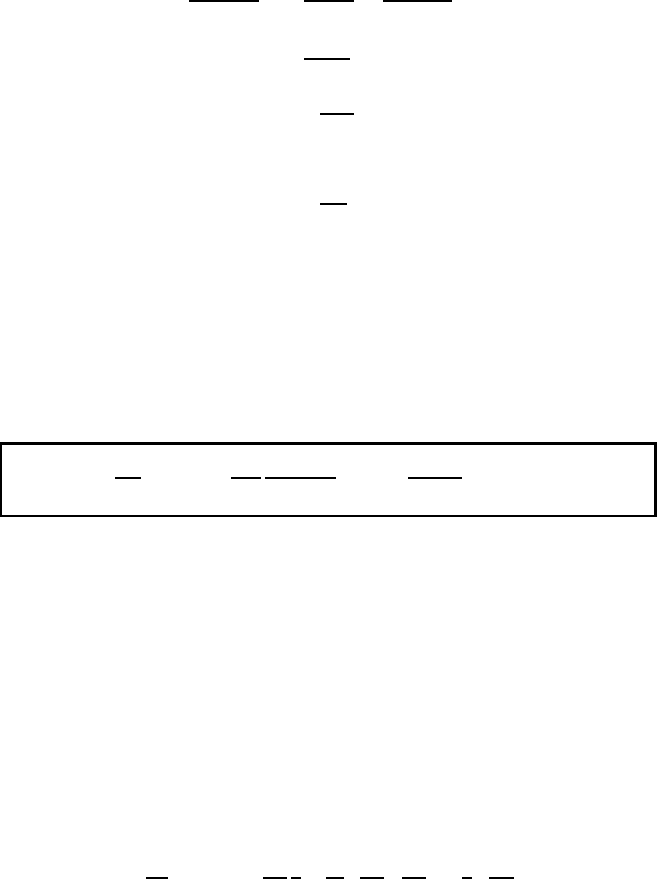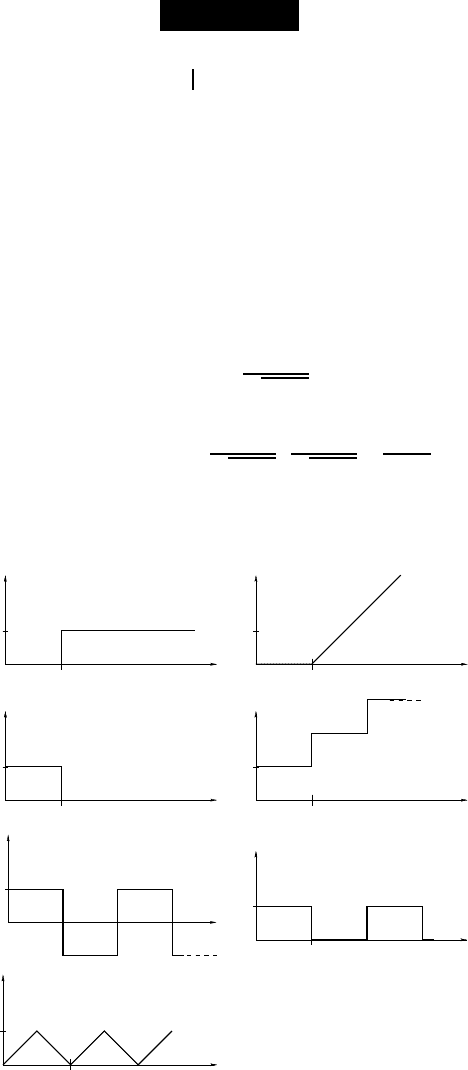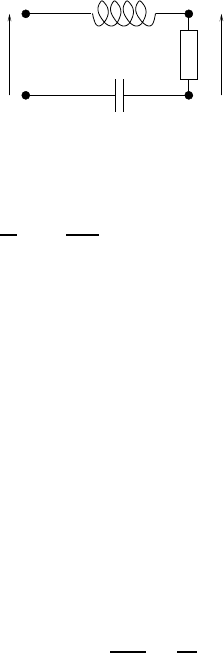Appel W. Mathematics for Physics and Physicists
Подождите немного. Документ загружается.


Physical applications, the C auchy problem 347
12.5.b A simple example
The Laplace transform can be used to s olve a differential equation, taking
initial conditions into account, in a more natural manner than wit h the
Fourier transform.
The b est is to start with a simple example. Suppose we want to solve the
following Cauchy problem:
(C )
¨x + x = 2 cos t,
x(0) = 0 ˙x(0) = −1.
We a ssume that the function x has a Laplace transform: x(t) ⊐ X (p). Then
the second derivative of x has the following Laplace transform, which incor-
porates the initial conditions:
¨x(t) ⊐ p
2
X (p) − p x(0) − ˙x(0) = p
2
X (p) + 1,
while
cos t ⊐
p
p
2
+ 1
.
The differential equation (with the given initial conditions) can therefore be
written simply in the form
p
2
X (p) + 1 + X (p) =
2p
p
2
+ 1
,
which is solved, in th e sense of functions
3
, by putting
X (p) =
2p
(p
2
+ 1)
2
−
1
p
2
+ 1
.
There only remains to find the original of X (p). The second term on the
right-hand side of the preceeding relation is the image of the sine function:
sin t ⊐ 1/(p
2
+ 1). Moreover, using Theorem 12.21, we obtain
t sin t ⊐ −
d
dp
1
p
2
+ 1
=
2p
(p
2
+ 1)
2
,
which gives the solution X (p) ⊏ t sin t −sin t = (t − 1) sin t.
It is easy to check that x(t) = (t −1) sin t is indeed a solution of the stated
Cauchy problem.
The reader is referred to the table on page 614 for a list of the principal
Laplace transforms.
3
One can see the advantage of working wit h Laplace transforms, which are functions,
instead of Fourier transforms, which are distributions.

348 The Laplace transform
12.5.c D ynamics of the electromagnetic field w ithout sources
The example treated here is somewhat more involved.
Consider the free e volution of th e electromagnetic field in the space R
3
, in
the absence of a ny source. For reasons of simplicity, it is easier to study the
evolution of the potential four-vector A( r, t) in Lorenz gauge instead of the
evolution of the electric and magnetic fields. The initial conditions at t = 0
are given by the data of the field A( r, 0) = A
0
( r) and of its first derivative
with respect to t ime, which we denote by
˙
A
0
( r).
The equations which determine the field are therefore
A( r, t) = 0 for all r ∈ R
3
and t > 0,
A( r, 0) = A
0
( r) for all r ∈ R
3
,
˙
A( r, 0) =
˙
A
0
( r) for all r ∈ R
3
.
We denote by AA
A
A
AA ( r, p) the Laplace transform of A( r, t), and by
e
A(k, t) its
Fourier transform with respect to the space variable. We also denote by
f
AA
A
A
AA ( k, p) the double transform (Laplace transform for the variable t and
Fourier transform for the variable r).
We have, by the differentiation theorem 12.19 :
A( r, t) ⊐ AA
A
A
AA ( r, p),
∂
∂ t
A( r, t) ⊐ pAA
A
A
AA ( r, p) −A( r, 0),
∂
2
∂ t
2
A( r, t) ⊐ p
2
AA
A
A
AA ( r, p) − pA( r, 0) −
˙
A( r, 0),
and the evolution of the potential is therefore described, in the Laplace world,
by the equation
p
2
c
2
−△
AA
A
A
AA ( r, p) =
p
c
2
A
0
( r) +
1
c
˙
A
0
( r).
Take then the Fourier transform for the space var iable, which gives
p
2
c
2
+ k
2
f
AA
A
A
AA ( k, p) =
p
c
2
e
A
0
(k) +
1
c
e
˙
A
0
(k),
or
f
AA
A
A
AA ( k, p) =
p
p
2
+ k
2
c
2
e
A
0
(k) +
1
p
2
+ k
2
c
2
e
˙
A
0
(k),
from which we can now take the inverse Laplace transform to derive, for any
t ¾ 0, th at
e
A(k, t) =
e
A
0
(k) H (t) cos(kc t) +
e
˙
A
0
(k)
H (t) sin(kc t)
kc
.
Finally we need only compute the inverse Fourier of t 7→ (sin kc t)/kc and
t 7→ cos(kc t).

Physical applications, the C auchy problem 349
THEOREM 12.36 The inverse Fourier transforms of those func tions are given by
F
−1
sin(kc t)
kc
=
1
(2π)
3
Z
sin(kc t)
kc
e
i k·r
d
3
k
=
1
4πc r
h
δ(r − c t) −δ(r + c t)
i
=
¨
1
4πcr
δ(r − c t) if t > 0,
0 if t = 0,
and F
−1
[cos(kc t)] =
¨
1
4πr
δ
′
(r − c t) if t > 0,
δ( r) if t = 0.
Proof. See Appendix D, page 603. The derivative δ
′
(v −c t) is assumed to be a radial
derivative.
The expression for the evolution of the field is then obtained by this last
inverse Fourier transform using the th e convolution theorem. Denoting by
∂B( r ; c t) the sphere centered at the point r w ith radius c t (i.e., the boundary
of the corresponding ball), we derive for t > 0 the formula
A( r, t) = −
1
4π
ZZ
∂B( r;c t)
∂
∂ n
A
0
( r
′
)
|r − r
′
|
d
2
r
′
+
1
4πc
2
t
ZZ
∂B( r;c t)
˙
A
0
( r
′
) d
2
r
′
.
where ∂/∂ n is the exterior normal derivative (in the direction the vector
exterior to the surface).
Notice that the value of the field at point r and time t is e xpressed in
terms of the initial values of the field and its derivative at points r
′
such that
|r
′
− r | = c t (th is is what appears in the integration domain ∂B( r ; c t)).
Note also t hat if we let t tend to 0 in this formula, the second term tends
to 0, whereas the first one tends to A
0
( r) if A
0
is suffi ciently regular (it is
enough that it be of C
1
class here).
Exercise 12.4 As an exercise, the reader may show that the previous formulas may be recov-
ered using the Kirchhoff integral presented in Problem 3 on page 24 4 .
Start by showing that, i f S is an arbitrary (smooth) surface, and if ψ( r, t) is a scalar field
such that ψ = 0, then by decomposing ψ in monochromatic waves via a Fourier transform
with respect to t, and using the results of Problem 3, we get
ψ( r, t) =
1
4π
ZZ
S
−[ψ]
∂
∂ n
1
q
+
1
cq
·
∂ q
∂ n
∂ψ
∂ t
+
1
q
∂ψ
∂ n
d
2
S ,
where q is t he distance from r to the point of surface which is the i ntegration variable, and
∂/∂ n is t he exterior normal derivative. The quantities between curly brackets are evaluated at
the delayed time t − q/c.
To co nclude, take S = ∂ B( r ; c t) and show that the l ast formula recovers the framed
equation above.

350 The Laplace transform
We can also express the potential evolving from t = 0 in presence of a
current four-vector j( r, t) which is assumed to be known at any time, namely,
A( r, t) =
ZZZ
B( r;c t)
j
r, t −
1
c
|r − r
′
|
|r − r
′
|
d
3
r
′
−
1
4π
ZZ
∂B( r;c t)
∂
∂ n
A
0
( r
′
)
|r − r
′
|
d
2
r
′
+
1
4πc
2
t
ZZ
∂B( r;c t)
˙
A
0
( r
′
) d
2
r
′
.
In this last expression, the first term, produced by the sources, is given by a
volume integral; it is therefore clear that the current j( r, t) may be a distribu-
tion instead of a function.
Note that to be physically per tinent, we must impose that th e inital condi-
tions (the potential at t = 0 and its first derivative) must be compatible with
the initial conditions concerning the charge and current distribution.

Exercises 351
EXERCISES
Exercise 12.5 Let f (t) be an o riginal which is peri odic with period a. Show that its Laplace
transform may be written
F (p) =
1
1 −e
−pa
Z
a
0
f (t) e
−pt
dt.
Exercise 12.6 We prove here an intermediate result used in the proof of Theorem 12.19.
i) Let h : R → R be a differentiable function such that h and h
′
are integrable. Show that
lim
x→+∞
h(x) = 0.
ii) Deduce that if f is an original with convergence abscissa α, such that f is differentiable,
and if f
′
is also an o riginal with convergence abscissa α
′
, then for any complex number
p such that Re(p) > max(α, α
′
), we have
lim
t→+∞
f (t) e
−pt
= 0.
Exercise 12.7 Let J
0
be the Bessel function of order 0. Show that
∀t ¾ 0,
Z
t
0
J
0
(s) J
0
(t − s) ds = sin t.
(See the table on page 614.)
Exercise 12.8 Prove the following results, and draw the original functions in each case (k is
a given real number):
a) H (t −k) ⊐
1
p
e
−k p
,
b) (t −k) H (t −k) ⊐
1
p
2
e
−k p
,
c) H(t) − H (t −k) ⊐
1 −e
−k p
p
,
d)
∞
P
n=0
H (t −nk) ⊐
1
p(1 −e
−k p
)
,
e) H (t) + 2
∞
P
n=1
(−1)
n
H (t −2nk) ⊐
tanh(k p)
p
,
f)
∞
P
n=0
(−1)
n
H (t −nk) ⊐
1
p(1 + e
−k p
)
g) t H (t) + 2
∞
P
n=1
(−1)
n
(t −2nk) H (t −2nk) ⊐
1
p
2
tanh(kp).
These results are particularly useful in electronic and sig nal theory.
Exercise 12.9 Consider a mechanical system given by a dampened harmonic oscillator, de-
scribed by the equation ¨x −2˙x + x = f (t), where f (t) is an outside perturbation. We assume
that the system is initally at rest, that is, x(0) = ˙x(0) = 0, and that the outside pert u rbation
has the form
f (t) =
5
X
n=0
(−1)
n
H (t −nτ) with τ > 0.
Draw the graph of f , then find the solution t 7→ x(t) to the given Cauchy problem.

352 The Laplace tr an sfor m
SOLUTIONS
Solution of exercise 1 2.5. Put ϕ
def
= f
[0,a]
. Then we have f = ϕ ∗ H (t) X(t/a). Apply
then the convolution formula, remembering that H (t) X(t) ⊐ 1/(1 −e
−p
).
Solution of exercise 1 2.6
i) Since f
′
is integrable, the function f has a limit at +∞ (indeed, for any real number x
we have x: f (x) = f (0) +
R
x
0
f
′
(t) dt and this last expression, by definition, has a limit
as x tends to +∞).
ii) By definition of the convergence abscissa, for Re(p) > α, we know that t 7→ f (t) e
−pt
is integrable. Moreover, its derivative is then t 7→ f
′
(t) e
−pt
− p f (t) e
−pt
, which is
also integrable if Re(p) is larger than α and α
′
. Apply the n the previous result to th e
function h : t 7→ f (t) e
−pt
.
Solution of exercise 1 2.7. The Laplace transform of J
0
is given by
H (t) J
0
(t) ⊐
1
p
p
2
+ 1
.
We want to find the convolution H (t) J
0
(t) with itself, which has image
H (t) J
0
(t) ∗ H (t) J
0
(t) ⊐
1
p
p
2
+ 1
·
1
p
p
2
+ 1
=
1
p
2
+ 1
,
the original of whi ch is H (t) sin t.
Note that the formula stated is still valid for t ¶ 0 by the parity of J
0
.
Solution of exercise 1 2.8. The graphs are
k
1
k
1
k
1
k
1
1
2 k
1
k
1
4 k
Solutions of exercises 353
The formulas are obtained by simple application of the various properties of the Laplace
transform and summations.
Solution of exercise 1 2.9.
x(t) =
5
X
n=0
(−1)
n
1 + e
t−nτ
(t − nτ −1)
H (t −nτ).

Chapter
13
Physical applications of the
Fourier transform
13.1
Justification of sinusoidal regime analysis
When studying a linear system
1
it is customary to reason as follows: consider
a situation where the signal is purely monochromatic, and where the response
to an arbitrary signal is the sum of responses to the various frequencies th at
make up the signal. The sinusoidal analysis is then justified by stating that
If the system has for input a sinusoidal signal with given frequency ω,
then the output signal is necessarily sinusoidal with the same frequency ω.
For definiteness, let us look at the very pedestrian example of an electrical
circuit of RLC type (Resistors, Inductors, Capacitors). Assume that the input
signal is the circuit voltage t 7→ u(t), and the output signal is the resistor
voltage t 7→ v(t) (i.e., up to the factor R, the intensity of current in the
circuit).
1
For instance, a mechanical system with springs and masses, or an elec tric circuit built out
of linear components such as resistors, capacitors or inductors, or in the study o f the free
electromagnetic field, ruled by the Maxwell equations.

356 Physical applications of the Fourier transform
R
L
C
u(t) v(t)
Writ ing down the differential equation linking u and v, we obtain the
identity (valid in the sense of distributions):
u =
L
R
δ
′
+
1
RC
H + δ
∗v = D ∗ v,
which may b e inverted (using the whole apparatus of Fourier analysis!) to
yield an equation of the type
v(t) = T (t) ∗u(t),
where T is th e impulse response of the system, that is, T = D
∗−1
.
Let us restrict our attention to the case where the input signal is sinusoidal,
with pulsation ω (or frequency ν related to ω by ω = 2πν). The output signal
is assumed to be sinusoidal, with same pulsation ω. The equations are much
simplified because, formally, we have
“d/dt = iω”
(a differential operator is replaced by a simple algebraic operation). Define the
transfer function Z(ω) as the ratio between the output signal v(t) = v
0
e
iωt
and the input signal u(t) = u
0
e
iωt
:
Z(ω) =
v(t)
u(t)
=
v
0
u
0
.
When the input signal is a superposition of sinusoidal s ignals (which is, gen-
erally speaking, always the case), the linearity of the system may be used to
find th e output signal: it suffices to multiply each sinusoidal component of the
input signal by the value of the transfer function for the given pulsation and
to sum (or integrate) over the whole set of frequencies:
if u(t) =
X
n
a
n
e
iω
n
t
, then v(t) =
X
n
a
n
Z(ω
n
) e
iω
n
t
,
and if u(t) =
Z
a(ω) e
iωt
dω, then v(t) =
Z
a(ω) Z(ω) e
iωt
dω.
The only subtle point in this argument is to justify tha t the output signal
is monochromatic if the input signal is. T his step is provided by the following
theorem:
THEOREM 13.1 Any exponential signal (either real t 7→ e
−p t
or c omplex t 7→
e
2πiνt
) is an eigenfunction of a convolution operator.
